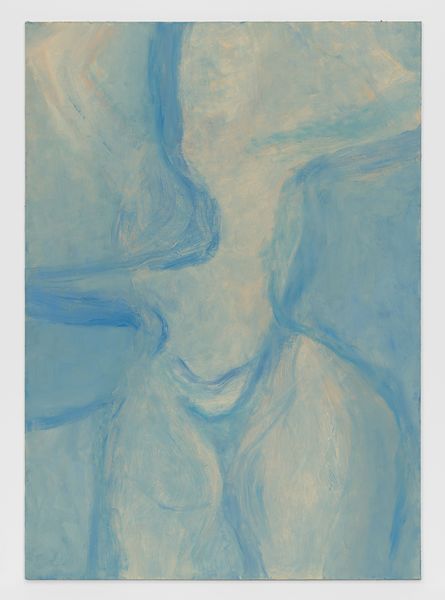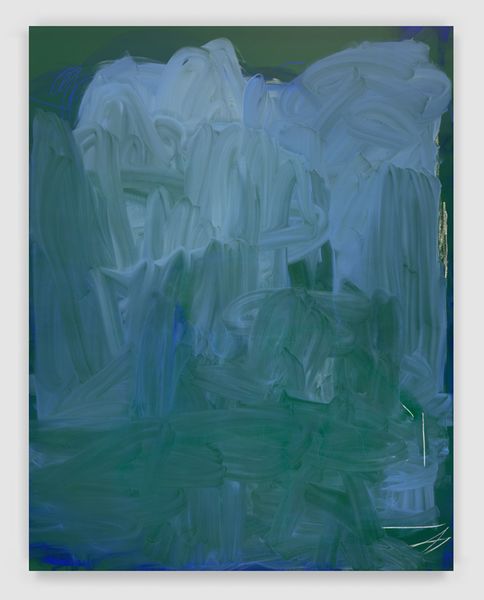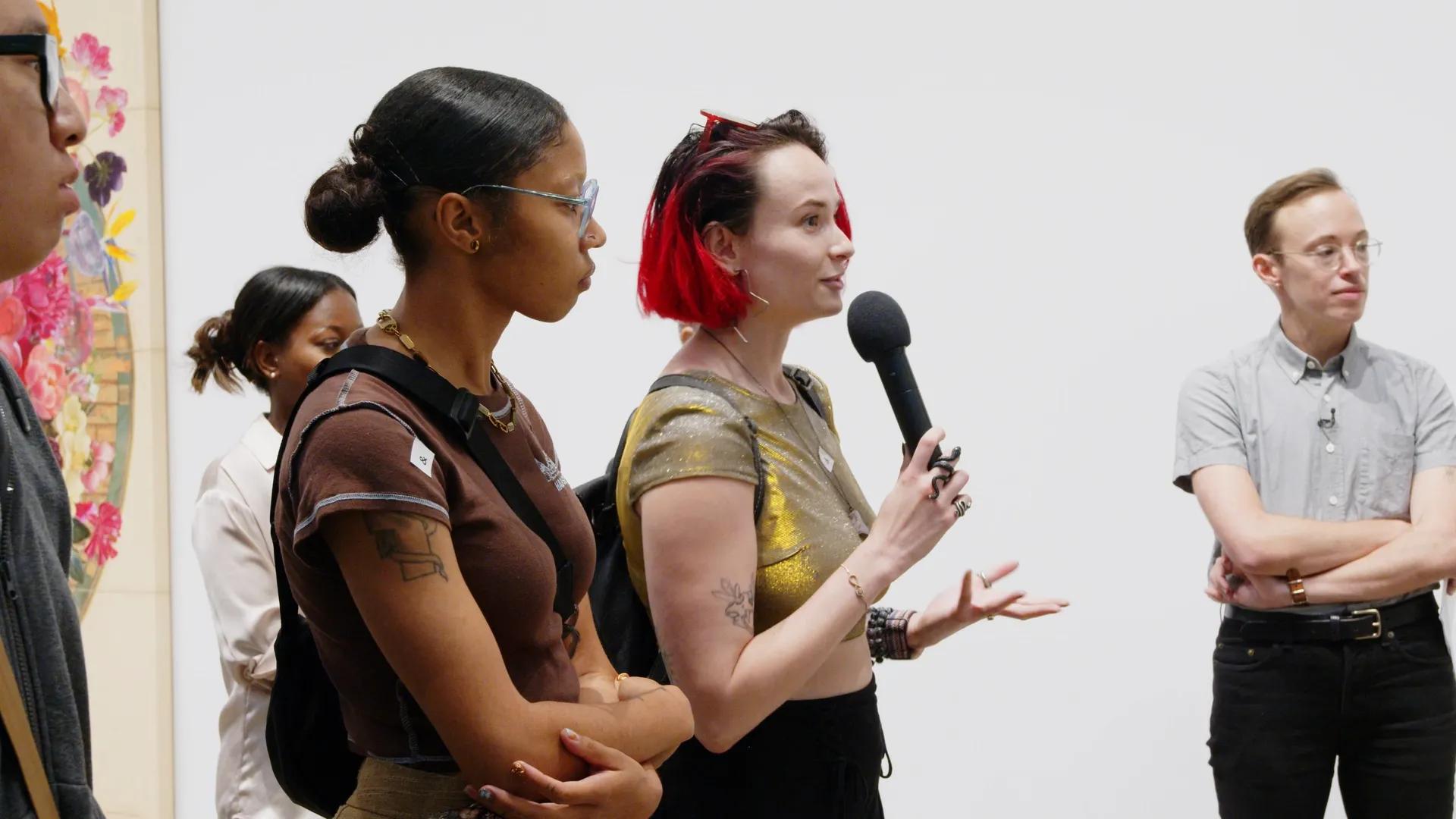
Installation view, ‘Rita Ackermann: Turning Air Blue’, Hauser & Wirth Somerset, 2017. © Rita Ackermann. Courtesy the artist and Hauser & Wirth. Photo: Ken Adlard.
Rita Ackermann. Turning Air Blue
This resource has been produced to accompany the exhibition, ‘Rita Ackermann. Turning Air Blue’, at Hauser & Wirth Somerset.
About Rita Ackermann
Rita Ackermann was born in 1968 in Budapest, Hungary. After her studies at the Academy of Fine Arts, Budapest (1989 – 1992) she moved to New York City where she studied at The New York Studio School of Painting, Drawing and Sculpture (1992 – 1993). In 2009 she spent several months in Marfa, Texas at the Chinati Foundation’s artist-in-residence programme, where she focused on the abstract conceptual elements of her work.
Her work has been featured in numerous solo and group shows internationally including ‘KLINE RAPE’, Hauser & Wirth, New York (2016 – 2017); ‘The Aesthetic of Disappearance’ at Malmö Konsthalle, Malmo, (2016); ‘Chalkboard Paintings’ at Hauser & Wirth, Zürich (2015); ‘MEDITATION ON VIOLENCE – HAIR WASH’ at Sammlung Friedrichshof, Zurndorf, and Sammlung Friedrichshof Stadtraum, Vienna (2014); ‘Negative Muscle’, Hauser & Wirth, New York (2013); ‘Fire by Days’, Hauser & Wirth, London (2012); Museum of Contemporary Art, North Miami (2012); ‘Bakos’, Ludwig Museum, Budapest (2011); and ‘Rita Ackermann and Harmony Korine: ShadowFux’, Swiss Institute, New York (2010). Rita Ackermann currently lives and works in New York. SaveSave

Rita Ackermann, 'Nude 21', 2017, oil on board © Rita Ackermann

Rita Ackermann, 'Turning Air Blue II', 2017, oil and pigment on canvas © Rita Ackermann
What inspires her work?
Music and dance are particularly important to Rita Ackermann; she believes that the process of painting involves a pattern of unconscious movements that we can consider to be a dance. She listens to a range of music from Niccolò Paganini to Philip Glass to Gang Gang Dance. Ackermann names Maya Deren, the dancer and experimental film maker, as her ‘eternal icon’.Another film maker referenced by Ackermann is Werner Hezog and in particular his 2010 ‘Cave of Forgotten Dreams’ about the Chauvet Cave in southern France, which contains the oldest human-painted images yet discovered. Whilst at art school Ackermann looked at the Viennese Actionists, a radical and explicit form of performance art that developed in the Austrian capital during the 1960s, and Cobra, a group of Expressionist painters formed in Paris in 1948 by Netherlandish and Scandinavian artists.
What does her exhibition look like?
‘Turning Air Blue’ extends through two galleries and doubles as an organic continuation of Somerset’s rural setting. The exhibition starts in the Rhoades gallery, which features a body of work titled The Coronation and Massacre of Love. The paintings here are large-scale compositions on canvas primed with chalkboard paint, on which washes of white chalk and green and blue pigments have been applied. These Abstract Expressionist-like works are reminiscent of actual chalkboards in a classroom, covered with unintentional erasures and marks, yet they have been conceptually executed by multiple deletions of figurative drawings and landscapes. By way of these gestures, the revenant outline of the erased drawings often emerges into the foreground. The final picture is a record of these movements.

Rita Ackermann, Turning Air Blue I, 2017, oil and pigment on canvas © Rita Ackermann

Rita Ackermann, Coronation Of Love And Massacre I, 2017, acrylic, spray paint, pigment and chalk on canvas © Rita Ackermann
The exhibition continues into the Bourgeois gallery, which comprises two bodies of work: Turning Air Blue and Nudes. The paintings titled Turning Air Blue are large-scale pigment paintings on canvas where translucent figures suggest a feminine shape. These works derive from the Fire by Days series – paintings inspired by accident being the true enemy of intention – which formed Ackermann’s introductory exhibition at Hauser & Wirth, London, in 2012. The palette of these new works is rendered by flesh tones shading into blue. The large paintings have an airy lightness about them, contrasting with the much smaller Nudes. While these smaller framed oils bear a similar pigmentation, they are painted more thickly to evoke the physicality of the female body.

Rita Ackermann, 'Nude 22', 2017, oil on board © Rita Ackermann
What are her main themes?
The human figure, both present and absent, figurative and abstract, nude or thinly clad, alluding to the feminine, features often in Ackermann’s work. The nude figure is a tradition in Western art and expresses human energy and life as well as basic or complex emotions such as pathos. Ackermann’s nudes move between figuration and abstraction and put ‘us in touch with what remains ungovernable in the body’.
The artist states: ‘My work always starts out form the body or ends up with the body and body movements. The work I make is in close discourse with the body – with my body – even if it has no direct reference to it. I paint the body from within my head’. She refutes feminist readings of her work, and recalls that raised under Communism she did not grow up to differentiate on the basis of gender as women and men were perceived in this context as equal human resources. The series of work titled Turning Air Blue are a direct progression of Fire by Days, a major series Ackermann initiated in 2010, which heralded a merger of the non-representational and the figurative in her art. ‘Fire by Days’ was inspired by the appearance of a figure in an accidental spillage of paint.
Ackermann is interested in this Rorschach-like experience of seeing something recognisable in the accidental. Her chalkboard paintings touch on themes of creativity, mobility, disappearance and the limits of representation. ‘Chalk isn’t meant to last and has no importance as a material. Its sole purpose is to be erased after it has done the work. ’Ackermann has previously spoken about having to ‘destroy everything first […] in order to be able to create’ and here in these paintings absence creates presence, ‘Being there by being missed’.
This effacing of her own work is a concept first visited in a much earlier series of drawings from the 1990s, where ballpoint pen was layered on top of painted images, creating a transparent veil, whereby the original images disappeared and reappeared, invoking a sense of mobility within the works.

Rita Ackermann, 'Nude Turning Air Blue II', 2017, oil on board © Rita Ackermann

Rita Ackermann, 'Nude Turning Air Blue III', 2017, oil on board © Rita Ackermann
How does she make her paintings?
Process is intrinsic to the ‘chalkboard paintings’; Ackermann primes the canvas with traditional chalkboard paint before drawing out a figurative scene in chalk. The drawings are borne out of scenes from some of her early works – classically composed idyllic tableaus such as a couple embracing in a New York park. The drawings are then almost entirely washed away in forceful sweeping gestures that fluctuate between the visible and invisible, revealing only limited emphasis on method, subject and production.
Does she work in any other ways?
Ackermann made her name in the 1990s with paintings that featured a series of ‘enfant terrible’ girls with almond shaped eyes. She has worked in a variety of ways including collage, ballpoint pen on linen and collaboration with the filmmaker Harmony Korine in which digital images were sliced and combined with painted areas. She has also created original album art work for Thurston Moore, painted the windows at the Lower East Side bar Max Fish and had her art work featured as designs for t-shirts. Ackermann formed and performed in a band ‘Angel Blood’ as well as producing shadow puppet theatre in the 1990s.
How does she title her work?
The series of chalkboard paintings takes its title from ‘Coronation of Massacre and Love’, a poem written in 1932 by the French avant-garde poet Roger Gilbert Lecomte (1907 – 1943) whose visionary poems explored what he called a ‘metaphysics of absence’. The poem describes the ‘spiritual downfall of a soul that has allowed itself to be lured into the snare of reincarnation’. ‘Coronation and Massacre of Love’ has seven verses and Ackermann has given each of the paintings one verse chosen at random. The poem doesn’t illustrate the paintings; rather Ackermann intends them to live side by side, forming a unique bond. She wants the viewer to create their own explanations as to how or why the verses may relate to the works. Ackermann says of the poem: ‘I can feel it on my skin and it chokes me up in my throat and it makes my heart pound faster. This is what I want my paintings to do to their audience’. The exhibition title ‘Turning Air Blue’ is taken from a line in a poem by Lecomte called ‘I’m Not Scared of Wind’. Ackermann has previously looked to poetry to title work as well as the writing of the French cultural theorist Paul Virilio. SaveSave

Rita Ackermann, 'Coronation Of Love And Massacre II', 2017, acrylic, spray paint, pigment and chalk on canvas © Rita Ackermann
What other artist’s work does it relate to?
In 2015 Ackermann executed eighteen graphite figure drawings that were reproduced in a volume with twenty-four charcoal figure drawings executed by the Abstract Expressionist painter Willem de Kooning in 1966. De Kooning, unlike his contemporaries, retained figurative elements in his painting and achieved notoriety with his ‘Women’ series. Other artists whose work use the female nude include Yves Klein whose Anthropométries were made using naked female models covered in blue paint and dragged across or laid upon canvases to make the image, using the models as “living brushes”. Art which focuses on the removal of marks rather than their accumulation recalls an early work of the artist Robert Rauschenberg, an almost blank piece of paper in a simple gilded frame. The work was created in 1953 by Rauschenberg erasing a drawing he obtained from Willem de Kooning. Rauschenberg asked his friend Jasper Johns to add a written caption to the frame, which reads: “Erased de Kooning Drawing, Robert Rauschenberg, 1953”.
Other artists to consider Ida Applebroog (born 1929) is an American painter currently living and working in New York. Since the 1970s Applebroog has been known for creating paintings, sculptures, artists’ books and several films that explore the themes of gender, sexual identity, violence and politics. Learn more about the artist here
Louise Bourgeois (1911 – 2010) was a French-American artist. Best known for her large-scale sculpture and installation art, Bourgeois was also a prolific painter and printmaker. She explored a variety of themes over the course of her long career including sexuality and the body, as well as death and the subconscious. Learn more about the artist here
Philip Guston (1913 – 1980), was a painter and printmaker in the New York School, an art movement that included many abstract expressionists. In the late 1960s Guston helped to lead a transition from abstract expressionism to neo-expressionism in painting, abandoning so-called “pure abstraction” in favor of more representational, cartoonish renderings of various personal situations, symbols and objects. Learn more about the artist here
Further Reading Moreno, Gean, Rita Ackermann and the Traumas of War, in: Art Papers, Atlanta GA, June/July 2012, pp. 28-33. Klocker, Hubert, ‘Rita Ackermann “Meditation on Violence” Exhibition Opening at Sammlung Friedrichshof, Burgenland,’ on: www.purple.fr, Paris, France, 30 April 2014 Clearwater, Bonnie, Ensslin, Felix, Kelsey, John (et al.), Rita Ackermann, New York: Skira Rizzoli, 2011 Grunthaner, Jeff, & Rita Ackermann Interview, on: www.whitehotmagazine.com, New York NY, 18 March 2015
Glossary Abstract Art
Abstract art is art that does not attempt to represent an accurate depiction of a visual reality but instead use shapes, colours, forms and gestural marks to achieve its effect.
Abstract Expressionism
Can be crudely split into two areas: colour field painters who covered their canvases with swathes of rich colour and action painters who poured and spattered paint. This includes the work of Mark Rothko, Jackson Pollock and Willem de Kooning.
Cobra
A group of Expressionist painters formed in Paris in 1948 by Netherlandish and Scandinavian artists. The name derived from the first letters of the capital cites of the three countries of the artists involved – Copenhagen, Brussels, and Amsterdam. Their aims were to exploit free expression of the unconscious, unimpeded and undirected by the intellect. Leading members within Cobra include the artists Asgar Jorn (1914 – 1973) and Karel Appel (1921 – 2006).
Communism
In political and social sciences, communism is the philosophical, social, political, and economic ideology and movement whose ultimate goal is the common ownership of the means of production and the absence of social classes, money and the state. The communist rule in the Hungarian People’s Republic came to an end in 1989.
Expressionism
Expressionism refers to art in which the image of reality is distorted in order to make it expressive of the artist’s inner feelings or ideas.
Maya Deren
Maya Deren (1917 – 1961) was a Russian-American experimental filmmaker and also a choreographer, dancer, film theorist, poet, lecturer, writer and photographer. Using editing and multiple camera techniques Deren created a series of surreal, black and white short films that abandoned the established notions of physical space and time.
Figurative
Figurative refers to portraying the (human or animal) figure. Figurative sculpture or painting can be either realistic (in varying degrees) or stylized.
Roger Gilbert-Lecomte
Roger Gilbert-Lecomte (1907 – 1943) was a French avant-garde poet and co-founder of the artistic group and magazine Le Grand Jeu. The group, associated with surrealists, was “excommunicated” from the movement by André Breton.
Postmodern
Postmodernist is a way of describing cultural movements and styles since the 1960s. It is often described as demonstrating a blurring of the boundaries between high and low culture. It does not recognize a single authority, style or method of working.
Yves Klein
Yves Klein (1928 – 1962) was a French artist considered an important figure in post-war European art. He is the leading member of the French artistic movement of Nouveau réalisme founded in 1960. Klein was a pioneer in the development of performance art, and is seen as an inspiration to, and as a forerunner of, minimal art, as well as pop art.
Willem de Kooning
Willem de Kooning (1904 – 1997) was an American Abstract Expressionist painter who retained figurative elements in his work and achieved notoriety with his ‘Women’ series. ‘Woman I’ with its grotesque leer and frenzied brushwork, shocked the public and dismayed critics who believed in a rigorously abstract art.
Robert Rauschenberg
Robert Rauschenberg (1925 – 2008) was an American painter and graphic artist whose early works anticipated the pop art movement. Rauschenberg is well known for his “Combines” of the 1950s, in which non-traditional materials and objects were employed in innovative combinations.
Viennese Actionists
The term Viennese Actionism refers to a violent, radical, and explicit form of performance art that developed in the Austrian capital during the 1960s. They used their work to make taboo-breaking, often illegal, and sometimes repellent statements that expressed violent dissatisfaction with what they saw as the uptight, bourgeois government and society of post-World War II Austria.
Suggested Activities During Your Visit
Note: you will need to bring pencils and a sketchbook.
Activity 1
Before entering the galleries use a pencil or graphite stick to shade a side of A4 paper. Just as important as that object itself, negative space is the space that surrounds an object. Use a rubber to draw negative space around sculptural forms in the cloisters and/or Threshing Barn galleries.
Activity 2
Without looking at your paper, eyes only on one of the paintings in front of you, explore what you see by making one continuous pencil line.
Activity 3
Choose an art work and interpret it with senses other than the visual; pupils can respond physically with their bodies through movement, making sounds, or through drama/role play developed from their responses to the art works.
Activity 4
Choose one work of art and imagine yourself in the shoes of the artist. Explore how the artist would physically have made the work. How would they have moved? Where would they have stood? What actions, movement and gestures would they have used? What materials did they use?
Practical activity prompts and ideas for discussion following your visit
Key Stage 1 and 2
Produce a series of paintings made with different methods. You could pour, drip or splash the paint onto a surface. You could try applying a thick paint and scraping it away or using masking tape to make shapes, painting over it then peeling the tape away to reveal white marks.
Key Stage 3
Wear a blind-fold and use a pencil line to draw as you listen to different music; classical, experimental, heavy metal, jazz, pop. How can you use line to record sound? Think about the characteristics of the sound is it smooth, does it jar, is it soft or harsh etc.?
Key Stage 4 and beyond
Studying the human form and how it has been portrayed by artists throughout history, such as Titian and Boucher, Manet and Picasso, as well as contemporary artists such as Jenny Saville. Allow students to put their observations into practice by drawing from a nude life model.
Supplementary Research
Moreno, Gean, ‘Rita Ackermann and the Traumas of War’, in: Art Papers, Atlanta GA, June/July 2012, pp. 28-33, ill. Klocker, Hubert, ‘Rita Ackermann “Meditation on Violence” Exhibition Opening at Sammlung Friedrichshof, Burgenland,’ on: purple.fr, Paris, France, 30 April 2014 Clearwater, Bonnie, Ensslin, Felix, Kelsey, John (et al.), ‘Rita Ackermann’, New York: Skira Rizzoli, 2011 Grunthaner, Jeff, ‘Rita Ackermann Interview,’ on: www.whitehotmagazine.com, New York NY, 18 March 2015
Resources
1 / 8









